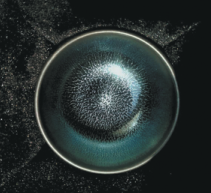I discovered something in Beijing recently that truly is, as the expression goes, my cup of tea.
Much as in romance, it was the sheer beauty of what I beheld that first caught my attention. But it was the integrity of, and story behind, the objects of my obsession-jian zhan teacups-that eventually won me over.
Interestingly enough, many of my Chinese friends mistakenly believe these teacups, also called tea pots for their sturdy construction, are of Japanese origin.
But this clay teaware that I've grown so fond of has a long tradition in China, with roots reaching back to Fujian province in the Song Dynasty (420-479).
The beauty of the cups comes from the iron-rich clay and glaze used in making them, as well as the glorious transformation that occurs in the superheated, fire-belching traditional kilns. The result is an astounding array of spectacular glaze colors and patterns.
The appreciation of jian zhan increases as one gains a better understanding of how a certain magic determines the magnificence, and hence the asking price, of these unique teacups.
In the West, the word "teacup" often calls to mind dainty porcelain pieces meant for genteel sipping. Jian zhan, however, are weighty in the hand and solidly constructed, and tea sophisticates swear by them.
According to the website of Crimson Lotus Tea, "When we're analyzing teas for purchase we can't use these cups. They make everything taste better."
The website Verdant Tea says jian zhan absorb tea oils over time and tend to "smooth out teas, bringing out their sweetness while evening out texture".
Some fans, including myself, buy a single special cup that comes with a fancy wooden or leather carrying case.
My favorite jian zhan, purchased recently for a mere 650 yuan ($93), is a gorgeous blue whose sheen on the inside rim reminds me of a favorite Bianchi bicycle from years back, which had light blue, metal-flake paint that virtually glowed in sunlight.
The process by which jian zhan take shape begins with the earth underfoot, or more precisely the clay. And not just any clay, but a very special type specific to Fujian.
The Lawrence Berkeley National Laboratory says this about the teacups' composition: "New analysis of ancient Jian wares reveals the distinctive pottery contains an unexpected and highly unusual form of iron oxide. This rare compound, called epsilon-phase iron oxide, was only recently discovered and characterized by scientists and so far has been extremely difficult to create with modern techniques."
The lab says the findings by an international team of researchers "could lead to an easier, more reliable synthesis of epsilon-phase iron oxide, enabling better, cheaper magnetic materials including those used for data storage".
The Berkeley Lab summarizes the jian zhan production process thusly: "To make the pottery, ancient artisans used local iron-rich clay coated with a mixture of clay, limestone, and wooden ash. Kiln temperatures of 1,300 C(nearly 2,400 Fahrenheit) hardened the clay, melted the coating, and bubbled oxygen within the glaze, pushing iron ions to the surface. As the glaze cooled, molten iron flux flowed down the sides of the ceramics and crystallized into iron oxides imparting characteristic patterns."
And there you have it. But neither the lab nor any amount of science can explain why this ancient form of teacup is so endearing.
Maybe it's the dense, earthy feel that helps ground our thoughts and emotions as we drink tea. Perhaps it's the way the teacups dazzle the eye (some feature real leaves of golden autumn hues embedded beneath the glaze). Or maybe they appeal to our longing for simpler, traditional ways.
But whatever the reason, whenever I encounter these glorious reminders of long-ago China, I quickly succumb to their iron-flux magic.



